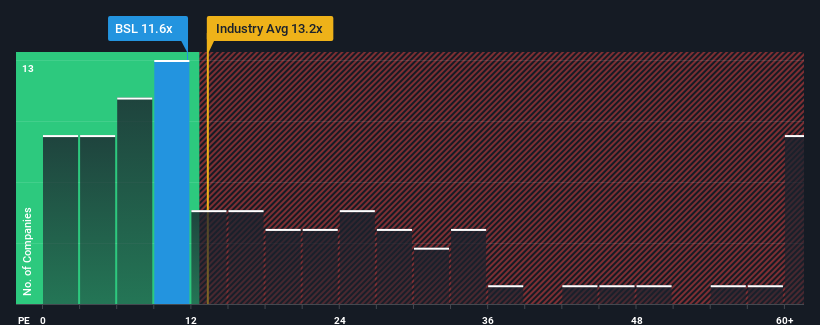- Australia
- /
- Metals and Mining
- /
- ASX:BSL
Why Investors Shouldn't Be Surprised By BlueScope Steel Limited's (ASX:BSL) Low P/E

With a price-to-earnings (or "P/E") ratio of 11.6x BlueScope Steel Limited (ASX:BSL) may be sending bullish signals at the moment, given that almost half of all companies in Australia have P/E ratios greater than 20x and even P/E's higher than 36x are not unusual. Nonetheless, we'd need to dig a little deeper to determine if there is a rational basis for the reduced P/E.
BlueScope Steel hasn't been tracking well recently as its declining earnings compare poorly to other companies, which have seen some growth on average. The P/E is probably low because investors think this poor earnings performance isn't going to get any better. If you still like the company, you'd be hoping this isn't the case so that you could potentially pick up some stock while it's out of favour.
View our latest analysis for BlueScope Steel

What Are Growth Metrics Telling Us About The Low P/E?
BlueScope Steel's P/E ratio would be typical for a company that's only expected to deliver limited growth, and importantly, perform worse than the market.
If we review the last year of earnings, dishearteningly the company's profits fell to the tune of 17%. This means it has also seen a slide in earnings over the longer-term as EPS is down 22% in total over the last three years. So unfortunately, we have to acknowledge that the company has not done a great job of growing earnings over that time.
Shifting to the future, estimates from the analysts covering the company suggest earnings should grow by 2.6% per annum over the next three years. That's shaping up to be materially lower than the 18% each year growth forecast for the broader market.
In light of this, it's understandable that BlueScope Steel's P/E sits below the majority of other companies. Apparently many shareholders weren't comfortable holding on while the company is potentially eyeing a less prosperous future.
What We Can Learn From BlueScope Steel's P/E?
We'd say the price-to-earnings ratio's power isn't primarily as a valuation instrument but rather to gauge current investor sentiment and future expectations.
As we suspected, our examination of BlueScope Steel's analyst forecasts revealed that its inferior earnings outlook is contributing to its low P/E. Right now shareholders are accepting the low P/E as they concede future earnings probably won't provide any pleasant surprises. Unless these conditions improve, they will continue to form a barrier for the share price around these levels.
You always need to take note of risks, for example - BlueScope Steel has 2 warning signs we think you should be aware of.
Of course, you might find a fantastic investment by looking at a few good candidates. So take a peek at this free list of companies with a strong growth track record, trading on a low P/E.
Valuation is complex, but we're here to simplify it.
Discover if BlueScope Steel might be undervalued or overvalued with our detailed analysis, featuring fair value estimates, potential risks, dividends, insider trades, and its financial condition.
Access Free AnalysisHave feedback on this article? Concerned about the content? Get in touch with us directly. Alternatively, email editorial-team (at) simplywallst.com.
This article by Simply Wall St is general in nature. We provide commentary based on historical data and analyst forecasts only using an unbiased methodology and our articles are not intended to be financial advice. It does not constitute a recommendation to buy or sell any stock, and does not take account of your objectives, or your financial situation. We aim to bring you long-term focused analysis driven by fundamental data. Note that our analysis may not factor in the latest price-sensitive company announcements or qualitative material. Simply Wall St has no position in any stocks mentioned.
About ASX:BSL
BlueScope Steel
Engages in the production and marketing of metal coated and painted steel building products in Australia, New Zealand, Asia, North America, and internationally.
Flawless balance sheet and fair value.
Similar Companies
Market Insights
Community Narratives



